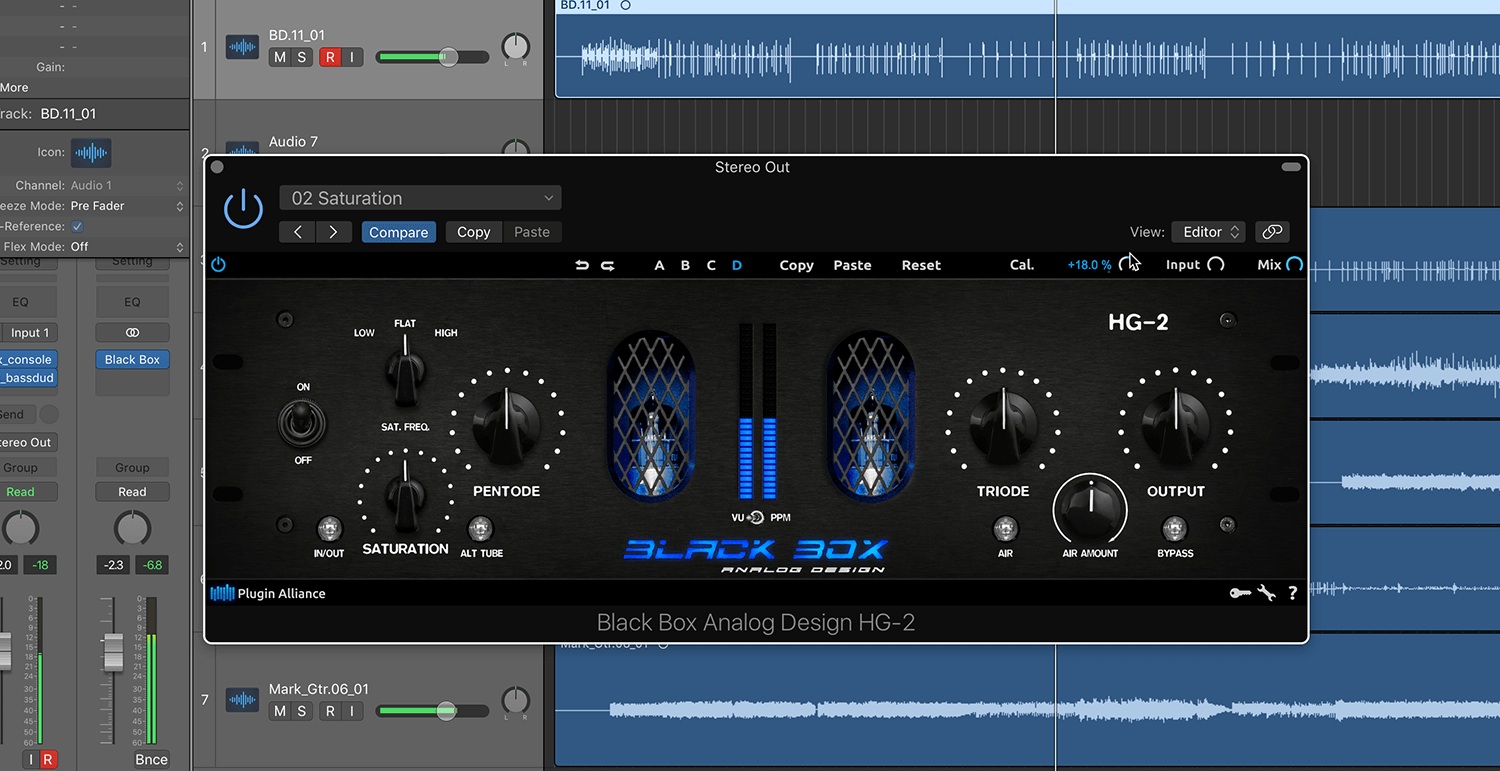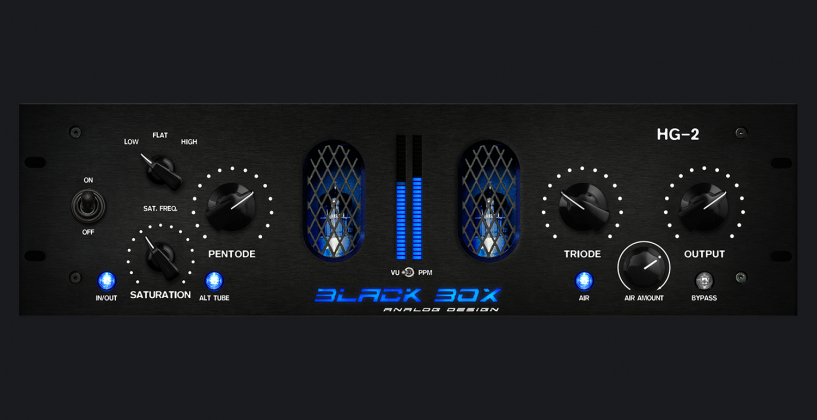New Software Review: Black Box HG-2 by Plugin Alliance

Whether on your mix bus or individual tracks, Plugin Alliance’s emulation of the Black Box HG-2 is sure to deliver a unique brand of rich harmonic texture to your sound sources.
The original HG-2 by Black Box Analog Design is a boutique, 2-channel, tube-based hardware unit that provides a wide variety of color options for your mix bus—with the flexibility and control expected of a modern processor.
Now, Plugin Alliance has designed a software emulation of the HG-2 that brings its three different vacuum tube stages (one of which provides two different tube options) to in-the-box mixers.
This plugin, just like the original hardware it models, was designed for use on the mix bus, but is also fair game for use on individual tracks in pursuit of a wide range of rich and varied harmonic textures.
Features and Use
First, it’s worth noting that there are two major sections here: The main stage and the parallel saturation stage, each of which consists of two separate tube emulations.
The Pentode and Triode sections make up the main tube stage of the HG-2, and each of them includes a continuous knob for control over drive.
The Pentode section generates “even order” harmonics—a pleasing type of saturation that can be found in many tube-based guitar amps. Meanwhile, the Triode section generates “third order” harmonics—a grittier type of saturation that can be found in overdriven audio tape.
An important note about these two sections is that they run in series, so pushing the Pentode drive harder also pushes the following Triode harder as well.
The Parallel Saturation circuit in the HG-2 includes a choice of two modeled 12AX7 tubes. One continuous knob, aptly labeled “Saturation,” allows you to adjust how much of this parallel saturation signal is fed into the main signal path. The first tube option is less aggressive than the second, which makes this stage useful for anything from adding a light tube radiance to scorching overdrive distortion.
An In/Out switch for the parallel circuit is found next to the Saturation knob, as well as a switch for ALT TUBE control on the opposite side, which toggles between the two different 12AX7 emulations.
Above these controls is a 3-stepped (LOW, FLAT, HIGH) selector that allows you to choose if the 12AX7 harmonics are applied to the low frequencies, full bandwidth, or the high frequencies—another very useful feature for adding a little body to a thin track or some sizzle to one that lacks excitement.
The final step in the HG-2’s signal path is the “AIR” section. By engaging this section via the 2-stepped button, you are given continuous control over the amount of post-saturation frequencies that are introduced around around 10kHz. The AIR feature is extremely pleasing, so be cautious not to overuse it as too much will lead to a thin/harsh mix. However, with the right amount applied, it can really open up the top end on your mix in a beautiful and unique way.
I even found the HG-2 to be of especially great use when set up as a parallel bus for tracks that need some extra aggression. The number of applications for the HG-2 is really countless. In fact, I had a little too much fun with it, putting it on just about everything—including FX returns.
As to be expected from a Plugin Alliance emulation, there are a handful of additional features unique to the plugin version only. The Output and Bypass parameters stay true to the hardware, however in the upper toolbar you will find some special features:

While otherwise very true to the hardware unit, Plugin Alliance took some liberties with the HG-2 and introduced extra features such as controls for calibration and “density,” along with a Mix knob for blending the processed signal into the dry signal.
First is a calibration drop-down menu which enables you to make some adjustments to the top end. The three options here are Dark, Norm, and Bright.
Next to the calibration controls is “Density”, which allows you to adjust the input gain, while the HG-2 plugin compensates by making a comparable adjustment to the output gain, achieving a denser, more saturated signal while preserving the current level of loudness.
An Input knob allows you to trim down the input level or push it to harder extremes, and last in the toolbar is the “Mix” knob which adjusts the blend between the unprocessed and saturated signals.
To Be Critical
At a price point of $249, the HG-2 is no small investment, likely making it an unjustifiable purchase for many hobbyists and amateurs.
One criticism I have would be that the metering could have been expanded upon, given that the HG-2 is marketed as a “mastering” tool.
Of course analog pieces of hardware have certain limitations, but for plugins in this day and age, numerical readouts and multiple meter types are to be expected—especially from mastering plugins.
This kind of faithful commitment to creating exact replicas of original hardware is common with many plugin emulations, and sometimes leads to shortcomings that could be easily avoided.
Summing it Up
I would absolutely recommend downloading the 14-day trial of the HG-2 to see how you can incorporate it into your workflow.
I found it extremely helpful on subgroups, enabling me to bring individual tracks together to form a cohesive package, from a vocal stack to a guitar group, and of course on the entire mix.
The thing that really made me appreciate the HG-2 on the mix bus was that it had a very similar effect to bus compression, but without the pumping, and with additional harmonic content instead.
If you are looking for a cleaner sound, you can utilize the Pentode and parallel saturation circuits in a subtle way. And, if you are looking for something a little more rough, you can reach for the Triode and ALT TUBE in the parallel saturation circuit.
I urge you to not think of the HG-2 as just a distortion box, because it is so much more than that. Along with adding color to your sound sources, it can also provide control over your dynamics in a much more musical manner than some compressors and limiters can.
Because of this, and the additional features provided by Plugin Alliance, the HG-2 plugin will likely become a mainstay in the arsenal of many producers, engineers, and mixers.
Please note: When you buy products through links on this page, we may earn an affiliate commission.







VanishingTiger
May 26, 2017 at 11:28 am (8 years ago)This is a fantastic plug-in, I use it on every master and on a bunch of individual tracks. It always sounds great.